Villages walk 40-year path to wealth
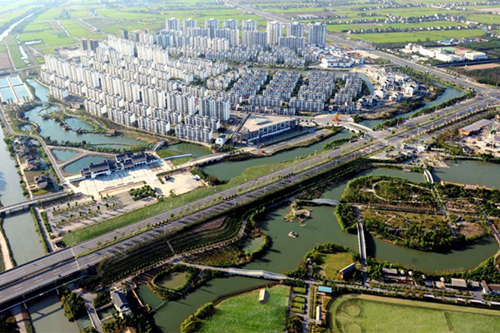
A view of Yonglian village in Zhangjiagang, Jiangsu province, which has risen from poverty over the decades. CHINA DAILY
Reform brings far-reaching changes to Jiangsu
The book Peasant Life in China, written by prestigious anthropologist and sociologist Fei Xiaotong in the 1930s, lifted the veil on the nation's rural areas to the outside world by documenting traditional life in a small village in Suzhou, Jiangsu province.
Fei was a pioneering researcher and professor noted for his studies of China's ethnic groups. He was born in Wujiang, Jiangsu, in 1910 and died in Beijing in 2005.
British social anthropologist Bronislaw Malinowski (1884-1942) wrote in the preface to Fei's book: "Our attention here is directed not to a small, insignificant tribe, but to the greatest nation in the world." The book was published in 1939 in the United Kingdom by Routledge.
The far-reaching changes that have taken place in Suzhou since the book was published have transformed it into one of China's wealthiest areas in the four decades since the reform and opening-up policy was launched.
Fei coined the term "the Sunan pattern" - literally the development path in southern Jiangsu - in 1983 at the age of 73 when he saw family-run village and township enterprises booming along the south bank of the Yangtze River, mainly in Suzhou, Wuxi and Changzhou.
He had concluded decades earlier that this vast rural area could develop industry to adapt to changing times. Gradually introduced urbanization led by industry helped to lift the people out of poverty in the early 1980s.
Cheng Changchun, a government counselor in Jiangsu and dean of the Jiangsu Yangtze River Delta Economic Research Institute, said, "The success and the transformative ability of the Sunan pattern is testimony to the effectiveness of the reform and opening-up policy."
Cheng said that as the Chinese economy finds itself on the "cusp of yet another quantum leap", continued prosperity under the Sunan pattern underscores the need for the national reform and opening-up policy to be deepened and widened.
Today, not many college graduates can resist decent pay and bright career prospects in a big city, but a few do.
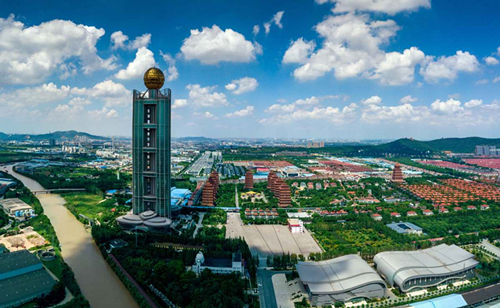
Huaxi in Jiangsu province is one of China's most prosperous villages thanks to reform and opening-up. CHINA DAILY
He Luwei, 37, who has a master's in economics, graduated from Zhejiang University in Hangzhou, the provincial capital, with a Certified Public Accountant qualification, but chose a career path different from that pursued by his peers in cities.
Ten years ago, he went to Huaxi village in Jiangyin city, Wuxi, Jiangsu, and to his surprise found an ideal job and a dream place for a long-term stay.
Now a senior accountant at a chemical fiber plant in Huaxi, where his wife was born, He said, "I've never regretted my decision to stay for the past 10 years." His wife graduated from Suzhou University.
The couple's annual income is about 400,000 yuan ($57,720), equivalent to that of a middle-class family in Beijing.
Dubbed the wealthiest village in the country for decades since the reform and opening-up policy was launched, the average annual personal income in Huaxi last year was 90,500 yuan. It was just 220 yuan in 1978.
According to the National Bureau of Statistics, the country's annual per capita disposable income was 25,974 yuan last year - 36,396 yuan for urban residents and 13,432 yuan for the rural population.
Huaxi, or "the village", as people still refer to it, is now a commercial giant with diversified business and investment in manufacturing, mining, finance, metallurgy, textiles, tourism, marine industry, new energy, high-technology and modern agriculture.
The village has a Shenzhen-listed company, Jiangsu Huaxicun Co, which saw revenue of just over 2 billion yuan last year, according to its annual report. The company was listed in 1999, making Huaxi the first village in the country with such an enterprise. The same year, the village's sales revenue reached 3.5 billion yuan.
Jiangsu Huaxi Group Co, which is overseen by the village and is collectively owned by the residents, saw revenue of 50 billion yuan last year, driven by its transformation from low-efficiency steel and textile businesses to high-end manufacturing, modern agriculture and high-technology.
Wu Xie'en, the village Party chief, said, "Our debt ratio is around 67 percent - completely reasonable and under control."
Villagers who were born and grew up in Huaxi, who number about 2,800, receive dividends each year as well as monthly pay.
"We are getting bigger and stronger by eating the 'reform meal'," Wu said. "Huaxi has caught the rhythm and each opportunity provided by reform and opening-up in the past 40 years."
Wu, the son of the former Huaxi Party chief Wu Renbao, who died in March 2013 aged 85, took over from his father in 2003 as village Party chief and chairman of Jiangsu Huaxi Group, which owns and invests in more than 80 enterprises at home and abroad.
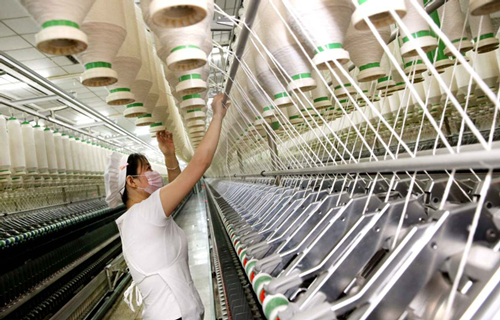
A worker from Henan province at the Huaxi Textile Factory is one of 25,000 migrants employed in the village. XU CONGJUN/FOR CHINA DAILY
Turning point
Most of the older generation in the village have Wu Renbao to thank for leading them out of poverty and into better homes with the wages to afford cars in the 1980s and '90s, when most of them took jobs at steel factories, thermal power plants and fiber businesses.
In 1988, Huaxi became the first village in Jiangsu to be named a "100 million yuan village". Just three years later, it had more than 20 enterprises with business worth 500 million yuan.
Such progress was partly due to neighboring Shanghai. Wu Xie'en said, "From 1978, we invited groups of engineers and technicians from Shanghai to train us at weekends with industrial development and technical skills.
"The weekend engineers' training course was a turning point, helping us to build up Huaxi's industrial base and broaden our horizons."
Led by Wu Xie'en, Jiangsu Huaxi Group's financial unit, V-capital, was launched in Shanghai in August 2015. With registered capital of 2 billion yuan, V-capital was managing 10 billion yuan in assets last year. V-capital has invested in CATL and Hero Entertainment, both unicorn enterprises (startups whose valuation has exceeded $1 billion).
Ten heavily polluting and inefficient steel plants have been closed in Huaxi since 2004, reducing 1.5 million metric tons of steel and iron capacity, or one-third of output.
"Dismantling 'blocks and walls' is crucial in our thinking to make further progress," Wu Xie'en said. "We have changed our methods and ways, but the path and beliefs remain the same."
Huaxi spread its wings to Africa in 2015 by investing in mining in Mozambique, and also the semiconductor sector in the United States.
By investing in a research team at Stanford University and in Gyrfalcon Technology in Silicon Valley in the US, V-capital has enabled Huaxi to hit the fast track to industrial upgrading and transformation.
A laser chips project based at the Wujin high-tech park in Changzhou, Jiangsu, is expected to start mass production next year, entering a market estimated to be worth 500 billion yuan.
Zhang Jianping, director of the Center for Regional Economic Cooperation affiliated to the Ministry of Commerce, said, "The Sunan pattern needs to progress and transform in the new era, and locals know they can't rest on past achievements.
"It's good to see the Sunan pattern seeking new growth points and an innovative development model and path."
With talent being the most important resource for future development, some professionals were sent to the US for short-term training, while others experienced weeklong "life experience" visits to the most underdeveloped areas in Qinghai and Guizhou provinces and the Xinjiang Uygur autonomous region.
He Luwei, the senior accountant, was among the first batch of 26 sent to Chuandong village, Kaiyang county, Guizhou, in October 2013.
"The trip allowed me to embrace disruptive thinking. Some of the pains and suffering I had complained about in the past were just imaginary illnesses," he said.
Chen Feng, 38, who graduated from Xi'an Jiaotong University in Shaanxi province, is now deputy head of the rice business in Huaxi's modern agriculture sector, and married to a local. Huaxi invested in the Asahi Noyu Farm in Japan to learn the techniques to grow high-quality rice and to learn about advanced farming.
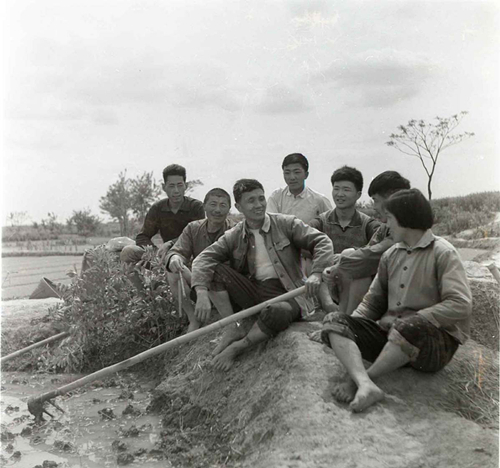
Wu Renbao (center), former Party chief of Huaxi village, chats with residents in the 1970s. CHINA DAILY
The price of Nanjing 46, a type of Huaxi rice dubbed the tastiest in Jiangsu, doubled to more than 20 yuan per kilogram after it was grown using the techniques and experience used in Japan.
Chen was among the first group to be sent to the West Point Military Academy in the US for a nine-day training course in December 2014.
"I now have a deeper understanding of what duty, honor and country means. Most of all, I came to realize humanity is the most important element. It helped to shape and consolidate my leadership style - that is to cherish talent," she said.
At Jiangsu Huaxi Group, 39 percent of the top executives are nonlocals, 60 percent of the middle management come from many different areas of the country, and 92 percent of the grassroots employees are from outside the village.
While sending its talent on people-to-people exchanges, Huaxi receives 2 million visitors annually from home and abroad, including 400,000 who arrive in groups to learn from its experience, said Ge Xiaoyan, who works in the village's reception office.
Yonglian village in Zhangjiagang, Suzhou, offers a similar story to that of Huaxi, but with variations.
Zhang, the Regional Economic Research Center director, said, "Huaxi and Yonglian have grown simultaneously, both in similar and different ways. Both have made great efforts in upgrading and investing more on research and development to enhance their competitive edge."
A giant golden sculpture featuring four fingers and a thumb stands at the entrance to Yonglian, which lies on a tributary of the Yangtze River with residential buildings on one bank and a village hall and museum on the other.
The magic touch of Wu Dongcai, 83, the village's former Party chief, transformed Yonglian from poverty to one of the country's richest model villages over the past 40 years. The golden fingers sculpture is a symbol of Yonglian's unity and a mark of respect for Wu, who lost the little finger of his right hand during the Korean War (1950-53).
Incomes rise
It is hard to believe that this modern and beautiful community is still called a village. But it is not difficult to understand why Yonglian was chosen as the only Chinese village to feature at the Milan World Expo in 2015, and one of only two from the country to be included in the Shanghai World Expo in 2010.
However, 40 years ago, Yonglian was the poorest, smallest and most isolated river town in Suzhou.
Founded in 1970, and built on 46.6 hectares of reed swamp along the Yangtze, it had just 254 households, or 700 villagers whose average annual income was 68 yuan in 1978. However, in the same year, Huaxi residents had flush toilets, and the village's development story had been heralded as a success in a lead story on the front page of People's Daily.
Yonglian now covers 12 sq km and is home to 19,000 people, whose average annual income last year was 43,688 yuan, higher than China's urban residents' per capita income of 36,396 yuan and 2.5 times the average rural income in Jiangsu.
Yonglian has become one of the richest villages in Suzhou, ranking top among the 640,000 counties in China in terms of economic achievement, tax payments, ecological environment, legal progress and cultural advancement.
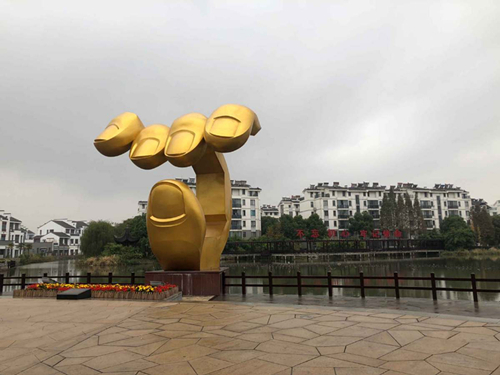
A sculpture at the entrance to Yonglian village, Jiangsu, stands as a symbol of Yonglian's unity, and commemorates former village Party chief Wu Dongcai. LIU WEIFENG/CHINA DAILY
"We were a small, poor village with limited arable land that was flooded every year. So why not try to grow the fishing industry instead of farming?" said Wu Dongcai, who faced opposition when he first raised the idea.
"I took the lead in digging a pond. We worked day and night for months before a meter-deep pond was completed," Wu said. Fish were raised in the pond and then sold.
By the end of 1978, each family had plenty of food, including fish, and in 1979 each villager received a year-end allocation of extra food and necessities.
That year, the term xiaokang (moderately prosperous society), was used by late leader Deng Xiaoping when he met with visiting Japanese prime minister Masayoshi Ohira and detailed the Four Modernizations, part of China's development roadmap and blueprint.
The Four Modernizations were goals set by Deng to strengthen the fields of agriculture, industry, national defense, and science and technology.
On Feb 5, 1983, Deng began an inspection tour of Suzhou, Hangzhou and Shanghai to study the feasibility of xiaokang. Yonglian was one of the three villages cited in a report to Deng for their advanced rural enterprises.
Twenty years later, Yonglian was among the first villages in the country to embrace the xiaokang standard of living. By the end of 1983, it was home to eight plants producing iron and steel, furniture, cement and pillow covers, with combined assets of 200,000 yuan.
Yonglian's industrial rise emerged from an opportunity to run a steel mill after an outsider arrived in the village to sell a steel rolling machine.
"He was on the point of leaving before I stopped him, because I realized the business opportunity presented by the metal, driven by villagers' demand to build bigger and better houses after they became better off," Wu Dongcai said.
On April 1, 1999, when Fei Xiaotong, the anthropologist, made a field study tour of Yonglian, he left with a calligraphy work titled Huaxia Diyi Gangcun (China's No 1 steel-making village).
Last year, sales revenue in Yonglian reached 40.3 billion yuan, generated mainly by its steel business the Yonggang Group, with a 75 percent stake held by the company and the remaining 25 percent owned by all the villagers.
Last year, Yonggang Group ranked 121st on a list of the country's top 500 private businesses by the All-China Federation of Industry and Commerce.
Wu Huifang was a colonel before he left the People's Liberation Army and returned to Yonglian to serve as its Party chief and to help improve living conditions. "Our villagers have become citizens who need education and deserve more civil rights," he said.
He was also behind the idea of building a village hall, which features Western-style architecture with state-of-the-art technology.
The idea of designing the hall came in 2011 when he was sent to California for a training course.
Visits to council venues in Carson, a city in Los Angeles County, impressed him. "Civilization can be learned and exchanged with others," Wu told online outlet The Paper.
He received inspiration from his US visit to build the 5,000-sq-m hall in Yonglian, describing it as "a place that enables grassroots democracy to be more visible and approachable among villagers".








